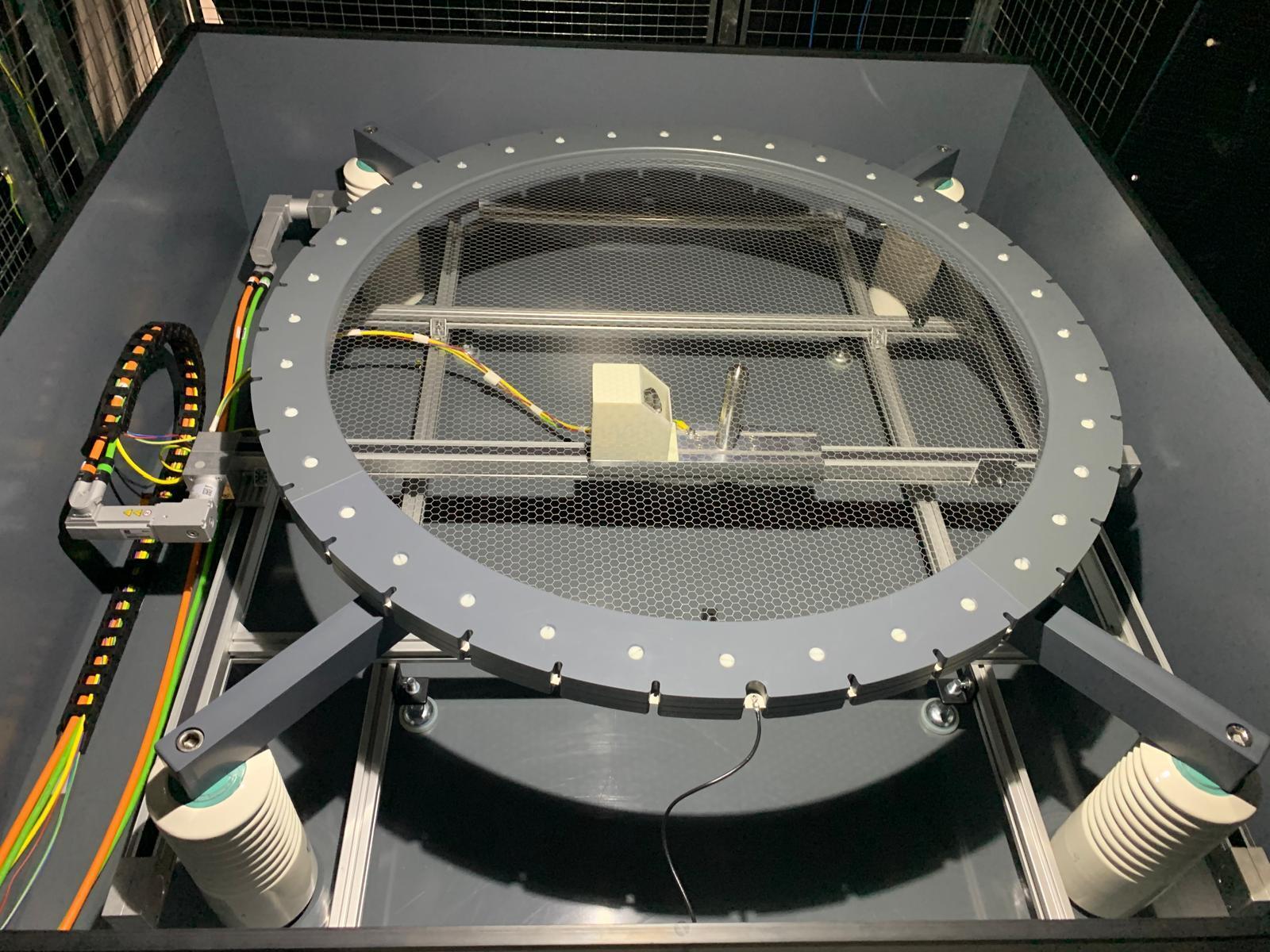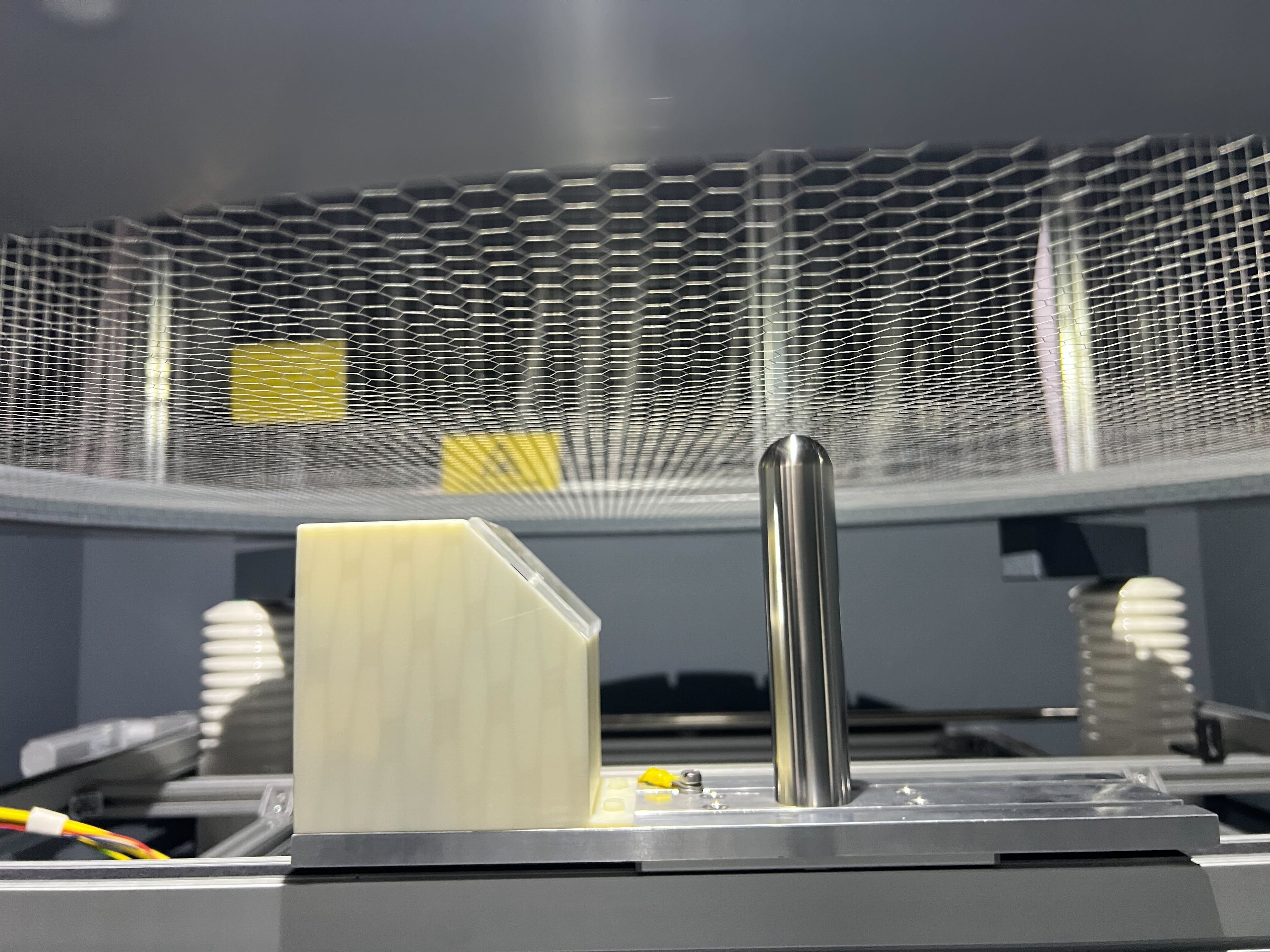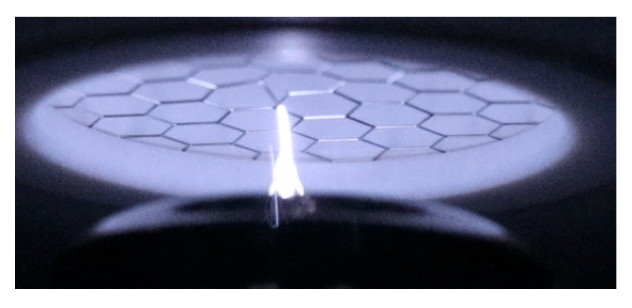Masterarbeiten
Mögliche Themen für Masterarbeiten (Stand September 2025):
- Automated Robotic High-voltage Scanning System for XLZD

 The XLZD collboration aims to design and construct the ultimate liquid xenon-based observatory for the direct detection of particle Dark Matter and studies of Neutrino physics. The performance of 3m in diameter mesh and wire electrodes, which will lie at the heart of the detector and will produce the fields necessary for signal generation is of paramount importance. The Dark Matter group plays a key role in R&D for the XLZD detector and established a dedicated program aimed at developing and testing such electrodes. Hence, we've devised the concept of a robotic high-voltage (HV) scanning system, which combines HV application with camera- and laser-based measurements. Using such a system we'd like to perform an automated targeted HV scan of the future XLZD's 3 meter sized electrodes with micrometer precision in gaseous argon, applying HV locally to each individual electrode segment. This will allow us to not only quantify each electrode's performance in unprecedented detail, but also to identify and subsequently repair any defects on the electrode's surface that otherwise would have detrimental effect on detector performance. Following the successful assembly and commissioning of a 1m HV scanning system prototype (shown in images), we now intend to construct a 3 meter HV scanning system that will be capable of scanning future XZLD electrodes. In the scope of the project you will be working closely with and supported by KIT engineers, physicists and industry experts, playing a key part in the realization of the HV scanning system, its commissioning and operation.
The XLZD collboration aims to design and construct the ultimate liquid xenon-based observatory for the direct detection of particle Dark Matter and studies of Neutrino physics. The performance of 3m in diameter mesh and wire electrodes, which will lie at the heart of the detector and will produce the fields necessary for signal generation is of paramount importance. The Dark Matter group plays a key role in R&D for the XLZD detector and established a dedicated program aimed at developing and testing such electrodes. Hence, we've devised the concept of a robotic high-voltage (HV) scanning system, which combines HV application with camera- and laser-based measurements. Using such a system we'd like to perform an automated targeted HV scan of the future XLZD's 3 meter sized electrodes with micrometer precision in gaseous argon, applying HV locally to each individual electrode segment. This will allow us to not only quantify each electrode's performance in unprecedented detail, but also to identify and subsequently repair any defects on the electrode's surface that otherwise would have detrimental effect on detector performance. Following the successful assembly and commissioning of a 1m HV scanning system prototype (shown in images), we now intend to construct a 3 meter HV scanning system that will be capable of scanning future XZLD electrodes. In the scope of the project you will be working closely with and supported by KIT engineers, physicists and industry experts, playing a key part in the realization of the HV scanning system, its commissioning and operation.
You will lead the assembly and commissioning of the recently procured 3 meter sized X-Y robotic system, as well as the development of the housing structure that will encapsulate the system. You will perform COMSOL simulations, developing and optimizing the design of various system components from electric fields perspective. Additionally, you will develop and assemble the laser-based positioning and sagging measurement for the system. You will also work on the python-based software used for operation of the system, significantly expanding and augmenting its capabilities. Subsequently, you will analyze the performance and functionality of the constructed system with a variety of test electrodes. You should enjoy working with hardware and have basic programming skills in languages such as Python or C++.
Project key topics: Hardware and software development, electric fields, data analysis
Project work scope: Closely supported by KIT engineers and industry experts
Project timeline: Available immediately
-
Exploring High-voltage Microphysics to Enhance XLZD Electrode Performance
 The international XLZD collaboration aims to design and construct the ultimate liquid xenon-based astroparticle observatory for the direct detection of particle Dark Matter and studies of Neutrino physics. Development of electrodes that will lie in the heart of the future XLZD detector is of paramount importance. Any such electrodes must withstand very large electric fields without causing detrimental electron emission or breakdown. A key component of the Dark Matter's group R&D towards XLZD electrodes is the work on high-volate (HV) microphysics, exploring ways for improving electrode performance. To that end we have constructed the bite-sized High Voltage setup for Electrodes (bHiVE), which allows us study the performance of cm-scale samples of electrodes in vacuum and gaseous environments. With bHiVE we aim to explore on smaller scales different electrode configurations and materials, as well as ways of mitigating electron emission from electrode surfaces via new coating and treatment methods. Lessons learned on these small scales will be then applied to the ongoing R&D of full-scale XLZD electrodes. The project is conducted in cooperation with University of Alabma and MPIK Heidelberg. Additionally, depending on your interests and project's timeline, your thesis project could be carried out in cooperation with the Institut für Angewandte Materialien (IAM) at KIT.
The international XLZD collaboration aims to design and construct the ultimate liquid xenon-based astroparticle observatory for the direct detection of particle Dark Matter and studies of Neutrino physics. Development of electrodes that will lie in the heart of the future XLZD detector is of paramount importance. Any such electrodes must withstand very large electric fields without causing detrimental electron emission or breakdown. A key component of the Dark Matter's group R&D towards XLZD electrodes is the work on high-volate (HV) microphysics, exploring ways for improving electrode performance. To that end we have constructed the bite-sized High Voltage setup for Electrodes (bHiVE), which allows us study the performance of cm-scale samples of electrodes in vacuum and gaseous environments. With bHiVE we aim to explore on smaller scales different electrode configurations and materials, as well as ways of mitigating electron emission from electrode surfaces via new coating and treatment methods. Lessons learned on these small scales will be then applied to the ongoing R&D of full-scale XLZD electrodes. The project is conducted in cooperation with University of Alabma and MPIK Heidelberg. Additionally, depending on your interests and project's timeline, your thesis project could be carried out in cooperation with the Institut für Angewandte Materialien (IAM) at KIT.
In the scope of the project, supported by KIT engineers, you will participate in the upgrade of the bHiVE setup, working both on hardware components and software development. You will conduct a series of tests of electrode samples under varying conditions in terms of pressure, gaseous atmosphere and electric fields, studying the effects of defects, treatment methods and coating variation on electrode performance. Subsequently, building upon existing python-based software, you will develop the analysis tools for statistical interpretation of the obtained data, comparing the results with expectations from computational models and theoretical predictions.
You should enjoy working with hardware and have basic programming skills in languages such as Python or C++.
Project key topics: Hardware and software development, electric fields, data analysis
Project work scope: Closely supported by KIT engineers and HV experts
Project timeline: Available immediately
-
Untersuchung eines Flüssig-Xenon-Vetos für das XLZD Experiment
Für den Erfolg des XLZD Experiments ist die Identifikation und Unterdrückung aller möglichen Untergrundquellen essenziell. Deshalb werden mehrere Strategien der Untergrundunterdrückung angewandt: Identifikation von Elektron- bzw. Kernrückstößen über das S1/S2-Signalverhältnis, Verwendung hochreiner Materialien in der TPC-Umgebung und aktive und passive Abschirmung des Detektors (Vetozähler, Wassertank und Untergrundlabor). Aufgrund der Konstruktion der TPC innerhalb eines doppelwandigen Kryostaten ergibt sich eine dünne Außenschicht von Xenon-Flüssigkeit („liquid Xe skin“), die als ein zusätzliches Veto-System instrumentiert werden kann.
In dieser Arbeit untersuchen Sie in detaillierten Simulationen die Wirksamkeit eines solchen „liquid Xe skin veto“ mithilfe des Programmpakets GEANT4. Dabei implementieren Sie zunächst die komplexe Geometrie inklusive möglicher Lichtsensoren (PMTs) im äußeren Bereich des Kryostaten, modellieren Untergrundreaktionen in diesem Bereich wie auch in der TPC und bestimmen, inwieweit diese Untergrundreaktionen in den PMTs registriert und somit letztendlich unterdrückt werden können.
Wir erwarten die Bereitschaft zur intensiven Auseinandersetzung mit dem Thema und Freude, sich in ein modernes, spannendes und für Sie neues Wissenschaftsfeld einzuarbeiten. Grundkenntnisse der Kern- und Teilchenphysik sowie von Teilchendetektoren sind notwendig. Grundkenntnisse in der Programmiersprache C++ sind Voraussetzung, Grundkenntnisse in Python und ROOT sind hilfreich.
-
Spektrale Vermessung des Neutronenflusses im Untergrundlabor Laboratori Nazionali del Gran Sasso (LNGS)
Unsere Arbeitsgruppe hat im Rahmen eines vom BMBF geförderten Projekts einen mobilen Neutronendetektor für das LNGS Untergrundlabor (ALMOND: An LNGS Mobile Neutron Detector) entwickelt und aufgebaut. Da Neutronen für viele Suchen nach seltenen Prozessen (z.B. Dunkle Materie-Wechselwirkungen, neutrinolose Doppel-Beta-Zerfälle) eine wesentliche Untergrundquelle darstellen, ist die verlässliche Bestimmung des Neutronenflusses am Ort des jeweils durchgeführten Experiments notwendig. Nach Kalibrationsmessungen am KIT und am Neutronengenerator des INFN-Labors in Frascati bei Rom befindet sich das Detektorsystem seit Anfang 2025 im LNGS und nimmt Daten. Der Neutronendetektor besteht aus 36 Szintillatormodulen, die von jeweils einem Photomultiplier (PMT) ausgelesen werden. Die Daten werden in digitaler Form zunächst am LNGS zwischengespeichert und dann in das lokale Rechnercluster transferiert. Für die nächsten Monate sind Langzeitmessungen des spektralen Neutronenflusses in den verschiedenen Hallen des LNGS geplant.
In dieser Arbeit analysieren Sie die aufgenommenen Daten und erstellen Spektren des Neutronenflusses an verschiedenen Stellen des LNGS. Dazu entwickeln Sie die Analyse-Softwarepakete weiter, Sie untersuchen u.a. die Langzeitstabilität des Gesamtsystems wie auch der Einzelmodule, Sie nutzen bereits erstellte Simulationen und Analysen zur Nachweiseffizienz der Neutronen in ALMOND und extrahieren die effektive Nachweisschwelle für durch Neutronen erfolgte Kernrückstöße im Szintillatormaterial.
Wir erwarten die Bereitschaft zur intensiven Auseinandersetzung mit dem Thema und Freude, sich in ein modernes, spannendes und für Sie neues Wissenschaftsfeld einzuarbeiten und in einem deutsch-italienischen Team mitzuarbeiten. Grundkenntnisse der Kern- und Teilchenphysik sowie von Teilchendetektoren sind notwendig. Grundkenntnisse in Python und ROOT sind hilfreich. Arbeiten direkt im Untergrundlabor LNGS in Italien sind ggf. möglich und erwünscht.
Project key topics: software development, data analysis
Project timeline: available immediately
-
Development of Machine Learning Analysis Techniques for Imaging of Dark Matter Induced Nanometer-sized Tracks in Minerals
Paleo-Detectors (PDs) represent a novel method for Dark Matter and Neutrino detection, which recently captured the interest of the Astroparticle Physics community. Dark Matter and Neutrino interactions can produce nanometer-sized damage tracks in certain natural crystals. While lying in the depths of the Earth over millions and billions of years, some crystals are expected to accumulate a large number of such tracks. These crystals can be excavated and imaged with cutting-edge nanometer-scale microscopy techniques, reading out these damage features, essentially using these minerals as PDs. With PDs we not only can probe a large range of Dark Matter particle masses, but also study Neutrinos from various astrophysical sources such as Supernovae and the Sun. Uniquely, these detectors will allow us to study the evolution of the fluxes of Dark Matter particles and astrophysical neutrinos over millions of years. Here at KIT we aim to conduct a series of key feasibility tests towards the realization of these detectors. A key aspect of realizing the PDs concept revolves around the ability to image and analyze the nanometer-scale damage tracks produced by particle interactions in the minerals.
In this project you will work on developing machine learning-based image processing algorithms for identification and subsequent characterization of minute features in microscopy imagery. The work could be based on similar existing algorithms that were already developed in the Dark Matter group for other purposes or take an new approach to the task. The ultimate goal will be to devise robust algorithms capable of identifying tracks produced by Dark Matter and Neutrinos and discriminating them from natural damage features or tracks produced by background particles.
Strong programming skills are required in either Python and/or C++ as well as keen interest in machine learning and data processing techniques.Project key topics: Machine learning, image processing, data analysis
Project timeline: available immediately
Für weitere Informationen wenden Sie sich gerne auch direkt an Prof. Dr. Kathrin Valerius oder Dr. Klaus Eitel.
